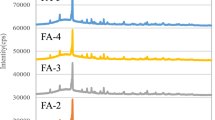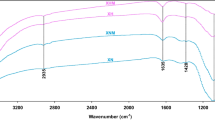Abstract
This study is focused on the speciation of selected elements in oil ash. Our efforts were directed primarily to obtain information on the various forms of vanadium, chromium and nickel. One sample was characterized via its total composition and via its capacity for releasing various elements. The latter was estimated by hot water and nitric acid extractios. A rapid cold water extraction technique has been developed and utilized for sample preparation prior to aqueous speciation by high pressure ion chromatography (HPIC).
Results of the HPIC measurements, in agreement with electron spin resonance (ESR) investigations performed on the solid sample, indicate that 38% of the vanadium is present as VOSO4, 58% of the chromium is Cr2(SO4)3 and 30% of the nickel is NiSO4. The pH and the redox potential values of the cold water extract support the existence of these forms. Results of a generic study with successive fractionation extractions show the probable existence of oxides, associations with organic matter and aluminosilicate minerals.
Similar content being viewed by others
References
Ainsworth, C. C. and Rai, D.: 1987, ‘Chemical Characterization of Fossil Fuel Combustion Wastes’,Report No. EA-5321, Electric Power Research Institute, Palo Alto, California.
Chao, T. T.: 1972,Soil Sci. Soc. Amer. Proc. 36, 764.
Eary, L. E., Rai, D., Mattigod, S. V. and Ainsworth, C. C.: 1990,J. Environ. Qual. 19, 202.
Flockhart, B. D.: 1971, ‘Nuclear Magnetic Resonance and Electron Spin Resonance Methods’, in C. L. Wilson and D. W. Wilson (eds.),Comprehensive Analytical Chemistry, Volume II/C, Elsevier Publishing Company, Amsterdam, London, New York.
Gjerde, D. T. and Mehra, H. C.: 1991, ‘Ion Chromatographic Speciation of Trace Metals’, in I. S. Krull (ed.),Trace Metal Analysis and Speciation, Journal of Chromatography Library Series, Vol. 47, Elsevier Science Publishers B.V., Amsterdam, pp. 213–237.
Henry, W. M. and Knapp, K. T.: 1980,Environ. Sci. Technol. 14, 450.
Lynch, J. J.: 1971, ‘The Determination of Copper, Nickel and Cobalt in Rocks by Atomic Absorption Spectrometry Using a Cold Leach’, in R. W. Boyle and J. I. McGerrigle (eds.),Geochemical Exploration, Volume II, The Canadian Institute of Mining and Metallurgy.
Nieboer, E.: 1992,Analyst 117, 550.
Rai, D., Ainsworth, C. C., Eary, L. E., Mattigod, S. V. and Jackson, D. R.: 1987, ‘Inorganic and Organic Constituents in Fossil Fuel Combustion Residues’, Vol 1, A critical review,Report No. EA-5176, Electric Power Research Institute, Palo Alto, California.
Robards, K., Starr, P. and Patsalides, E.: 1991,Analyst 116, 1247–1273.
Turner, R. R., Lowry, P., Levin, M., Lindberg, S. E. and Tamura, T.: 1982, ‘Leachability and Aqueous Speciation of Selected Trace Constituents of Coal Fly Ash’,Report No. EA-2588, Electric Power Research Institute, Palo Alto, California.
Ure, A. M.: 1991,Mikrochim. Acta II, 49–57.
Van der Sloot, H. A.: 1991, ‘Systematic Leaching Behaviour of Trace Elements From Construction Materials and Waste Materials’,Report No. RX-91-088, The Netherlands Energy Research Foundation, Petten.
Van der Sloot, H. A., de Groot, G. J., Hoede, D. and Wijkstra, J.: 1991, ‘Mobility of Trace Elements Derived from Combustion Residues and Products Containing these Residues in Soil and Groundwater’,Report, No. R-91-008, The Netherlands Energy Research Foundation, Petten.
Van der Sloot, H. A., van der Hoek, E. E., de Groot, G. J. and Comans, R. N. J.: 1992, ‘Classification of Pulverized Coal Fly Ash. Part I, Leaching Behaviour of Coal Fly Ash’,Report, No. C-92-059, The Netherlands Energy Research Foundation, Petten.
Van Loon, J. C. and Barefoot, R. R.: 1992,Analyst 117, 563.
Wu, E. J. and Chen, K. Y.: 1987, ‘Chemical Form and Leachability of Inorganic Trace Elements in Coal Ash’,Report No. EA-5115, Electric Power Research Institute, Palo Alto, California.
Zatka, V. J., Warner, J. S. and Maskery, D.: 1992,Environ. Sci. Technol. 26, 138.
Author information
Authors and Affiliations
Rights and permissions
About this article
Cite this article
Achilli, M., Zoboli, A., Gács, I. et al. Speciation of selected minor and major elements in oil ash I. Operationally defined chemical associations and aqueous speciation. Water Air Soil Pollut 93, 285–302 (1997). https://doi.org/10.1007/BF02404762
Received:
Accepted:
Issue Date:
DOI: https://doi.org/10.1007/BF02404762




